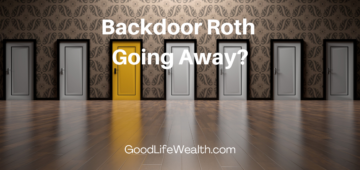The Tax Cuts and Jobs Act (TCJA) will impact Roth Conversions in 2018 and beyond in a number of significant ways for investors. Since I can hear the yawns already through my laptop, here’s why you should care: wouldn’t it be great to have your investment account growing tax-free? Once you are retired, which would you prefer: an account with $100,000 which you could access tax-free or one which will cost you $22,000 or more in taxes to use your money? Taxes can take a huge bite out of your investment returns.
Quick refresher: A Roth IRA holds after-tax money and grows tax-free. A Conversion is when you take a Traditional IRA, 401(k), or similar account, pay the taxes on it today, and transfer it to your Roth IRA. While that does mean paying taxes now, any future growth in the account would be tax-free. When you withdraw the money from a Roth IRA in retirement, you pay no taxes.
The TCJA has both positive and negative impacts on doing a Roth Conversion:
1. Lower tax rates. Under the TCJA, most people will receive a 1-4% reduction in their marginal tax bracket. For example, the top bracket was 39.6% in 2017 and will be 37% in 2018. If you are in the top bracket, a Roth Conversion is cheaper by 2.6% today.
For a married couple, if your taxable income is under $77,400 you are now in the 12% tax bracket. Paying 12% to convert an IRA to a Roth would be a bargain, but the Conversion plus your taxable income would need to stay under $77,400 to remain in the 12% rate. With a $24,000 standard deduction, a married couple could make as much as $101,400 and be in the 12% bracket.
To add a sense of urgency, don’t forget that the new lower tax rates are only temporary. In 2026, the top rate goes back to 39.6%. I suppose Congress could extend the tax cuts, but no one knows what will happen in eight years. What we do know is that deficits will rise dramatically, which suggests to me the need to have higher taxes in the future.
2. Beneficiary’s Tax Rate. If your beneficiaries – children, grandchildren, or anyone – are in higher tax bracket than you, the tax bill may be lower for you to convert your IRA to a Roth than for the beneficiaries to inherit the IRA. With a Conversion, your heirs inherit your Roth IRA tax-free. Also, converting to a Roth means you do not have to pay any Required Minimum Distributions (RMDs) starting at age 70 1/2, allowing your account to grow.
If you were planning to leave your Traditional IRA, perhaps in trust, to your young grandchildren, the TCJA will change how they are taxed. For children under age 18, or under age 24 if full-time students, they used to be taxed at their parent’s tax rate. Now for 2018, the “Kiddie Tax” will increase the tax on unearned income, such as IRA distributions, to the much worse tax rate of trusts, a 37% tax rate on income above $12,500.
3. The TCJA eliminated Recharacterizations. Previously, you could undo a Roth Conversion through a process called a Recharacterization. Why would you want to do that? Let’s say you converted $10,000 of a mutual fund from a Traditional to a Roth IRA in January; you would pay taxes on the $10,000 as income. Now, imagine that the account went down and was worth only $8,000 by November. You’d be pretty mad to pay taxes on $10,000 when your account was then only worth $8,000.
The Recharacterization would let you cancel your Roth Conversion if you didn’t like the outcome within that tax year. You could get a “Do-Over”. The TCJA eliminated Recharacterizations, so now if you do a Roth Conversion, you are stuck with it!
4. Back-Door Roth. Since 2010, there has been a type of Roth Conversion called a Back-Door Roth IRA. It allows high income investors who did not have any IRAs to fund a non-deductible Traditional IRA and then convert it to a Roth. It was a “Back Door” way to fund a Roth IRA if you made too much to qualify under the regular rules. There was discussion in Congress to eliminate the Back Door Roth IRA (as there has been for years), but in the final version of the TCJA, it is still allowed…for now.
So, should you convert your IRA to a Roth? If you are in a low tax bracket, 10% or 12% in 2018, I think it is worth consideration. If you are in a low tax bracket this year and anticipate your income rising substantially in future years, this would be a good year for a Conversion. You don’t have to convert your entire IRA. You could just convert a portion that would stay within your existing tax bracket. I suggest you use outside funds to pay the taxes, rather than the proceeds of the conversion.
If you are planning to leave your IRA to a charity, they can receive the funds without paying any income taxes and you should not do a Roth Conversion. In fact, if your estate plan includes donations to charity, the most tax-efficient solution is to make those donations from your Traditional IRA. Instead, leave your heirs money from taxable investment accounts; they can receive a step-up in cost basis and potentially owe little or no income taxes or capital gains.
If your IRA is invested in equities, converting when the market is at an all-time high is a risk. With the elimination of Recharacterizations, you don’t get a do-over if the stock market tanks after you do a conversion. It would be preferable to do a conversion is when your account is at a low point, such as in a Bear Market. Educate yourself now, and then in the future, if the market does go down by 25% or 30%, that would be an advantageous time to convert your investments to a tax-free Roth to enjoy the likely subsequent rebound.
In the mean time, if you have questions about Roth Conversions, or just choosing a Roth versus Traditional account for your 401(k), please send me a note. A Roth Conversion could possibly save you tens of thousands of dollars in retirement, which would definitely help elevate your lifestyle. It’s a big decision – often costing thousands of dollars in taxes today – so we have to make sure we are making a well-informed choice and have a thorough understanding of the costs and benefits.







